Volume 28 Issue 1, Winter 2023
by Amy Ulland, Stream Monitoring Coordinator
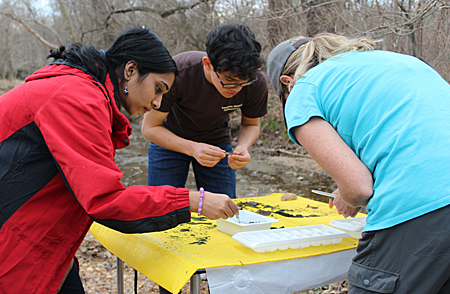
Volunteers Sharanya Maddukuri and Anthony Santos, and certified stream monitor Jennifer Venable sort macros collected from Limestone Branch Monitoring Site 4. Photo by Amy Ulland
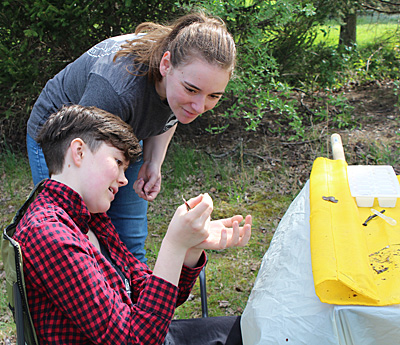
Certified stream monitors Emma Lloyd and Emily Maltman observe a macro collected from the Limestone Branch Monitoring Site 1. Photo by Amy Ulland
A stream can’t talk, but the benthic macroinvertebrates living at the bottom of the stream always have a story to tell. In the case of a tributary of Limestone Branch that flows through the JK Black Oak Wildlife Sanctuary just outside of Lucketts, these macros sounded the alarm about poor water quality concerns after Loudoun Wildlife Conservancy volunteers conducted two benthic macroinvertebrate surveys in May 2021. This prompted Loudoun Wildlife to reach out to Friends of the Shenandoah River to conduct bacterial testing, which indicated that high concentrations of E. coli were being discharged into the stream from a neighboring wastewater treatment facility (WWTF).
This became not only an environmental concern, but also a human health concern as the area’s karst topography results in the surface water quality directly affecting the groundwater quality. Because residents in the Lucketts area source their drinking water from wells supplied by groundwater fed by streams, the quality of these streams can affect the quality of their drinking water.
In January 2022, Loudoun Wildlife Conservancy received a $41,432 grant from the Tides Foundation on behalf of the Google Data Centers Grants Fund to support a “Securing Clean Drinking Water for the Lucketts Community” project. This yearlong project focused on:
- Determining the extent of E. coli contamination in two streams.
- Informing the community about this contamination and providing educational resources related to drinking water quality.
- Empowering the community in knowing if their drinking water was contaminated and offering solutions.
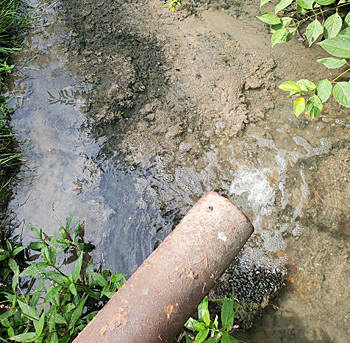
The wastewater treatment facility discharge pipe that empties into the Limestone Branch tributary adjacent to JK Black Oak. Photo by Amy Ulland
To determine the extent of E. coli contamination in the Limestone Branch tributary and Clarks Run in the Lucketts area, Loudoun Wildlife volunteers used a combination of bacterial and biological water quality testing. This included the collection and testing of 29 rounds of E. coli samples at six stream sites and two WWTF discharge pipes, as well as benthic macroinvertebrate testing at three sites in the spring and fall. (Click here to find data from these tests.)
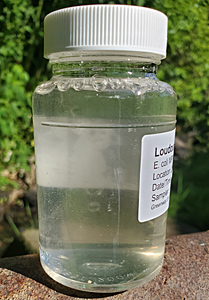
A water sample collected for E. coli analysis for the project. Photo by Amy Ulland
Over 70% of E. coli samples from all stream sites had E. coli concentrations higher than the threshold for recreational use (235 CFU per 100 mL of water) as defined by the Virginia Department of Environmental Quality (VA DEQ). These E. coli values tended to spike — sometimes over 41 times the safety threshold — following rain events, which was likely due to runoff from area E. coli sources such as horse, cow, and wildlife waste. Other sources of E. coli include sewage coming from failing residential septic systems and wastewater treatment facilities.
The Limestone Branch WWTF discharge pipe samples exceeded the VA DEQ facility permit limit of 126 CFU in 15 out of 28 sampling events, with two of these samples having an E. coli concentration 192 times the permit limit. Loudoun Wildlife provided these results to VA DEQ, which in turn shared them with the federal Environmental Protection Agency (EPA) — which was already investigating this WWTF. Ultimately, EPA mandated that the owners of this WWTF had 2.5 years to plan for the construction and completion of a new facility.
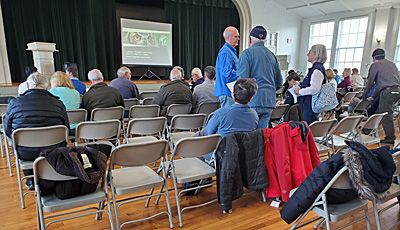
Attendees at the Loudoun Wildlife-hosted meeting at the Lucketts Community Center in April. Photo by Amy Ulland
To inform the Lucketts community about the extent of this E. coli contamination and provide educational resources, Loudoun Wildlife hosted a town hall-style meeting, created a project webpage, and worked in partnership with the Lucketts Ruritans, who graciously published articles about the project in their spring and fall Lucketts News and Notes newsletters.
Forty-five people attended a meeting at the Lucketts Community Center in April that included a panel of speakers from the Loudoun County Health Department, Loudoun Soil and Water Conservation District, Virginia Cooperative Extension’s Loudoun branch, and a professional geologist, who covered topics relating to the project, including E. coli, proper well and septic maintenance, affordable drinking water testing, and the interplay of karst topography and water quality. (Click here for more information about resources concerning well water and septic systems, and here for more information about topography and water quality.)
The project assisted the residents of the general Lucketts area by providing educational, testing, and technological resources resulting in clean drinking water. Among those helped were two underserved minority communities within the village of Lucketts, who were extremely concerned about the quality of their water.
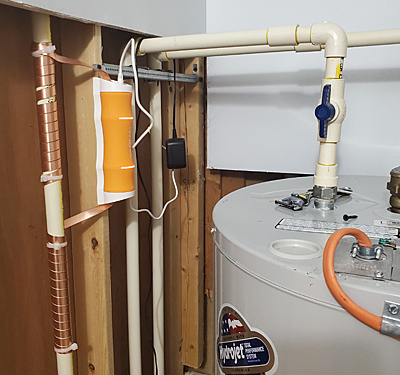
An electronic water descaler installed at a mobile home park residence in Lucketts. Photo by Amy Ulland
Loudoun Wildlife provided comprehensive drinking water assessments to 17 Hispanic families, consisting of 65 individuals, living in two mobile home park communities. Each family was spending up to $3,600 a year on bottled water, as they believed their water wasn’t safe to drink or cook with.
Data showed that their drinking water was completely safe to use, though “very hard” with a high mineral content. Still, the families indicated that they did not trust the results and would continue to drink bottled water. Loudoun Wildlife then purchased electronic water descalers and high-quality countertop water filtration systems for the families to allow them to feel safe consuming their tap water. These descalers and filtration systems will result in a savings of up to $14,400 for each family over four years, and up to $244,800 for all 17 families over four years.
Loudoun Wildlife also provided no-cost well-water quality panels to six households in the greater Lucketts area and provided the homeowners with resources about how to deal with the presence of coliform bacteria, lead, and iron.
Through this grant project, Loudoun Wildlife demonstrated the positive impacts that citizen science can have at a community level by turning our water quality data into action. This resulted in positive tangible impacts for the Lucketts community, including improvements in human health, increased awareness of surface water and drinking water quality issues, and economic relief for underserved minority communities.

